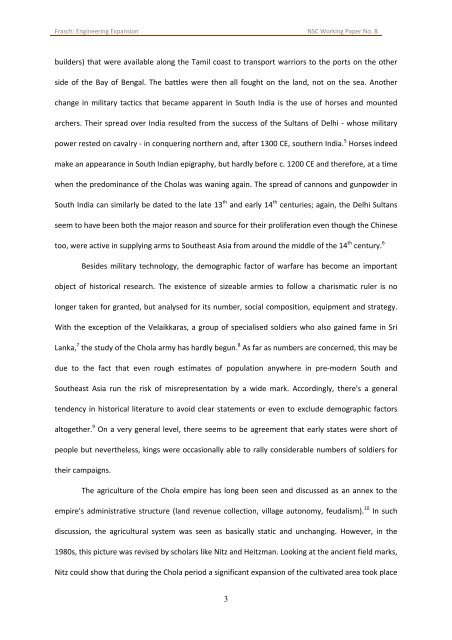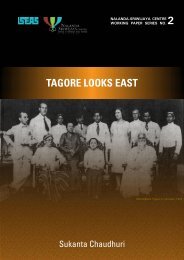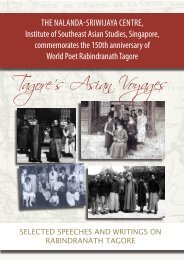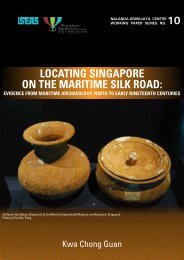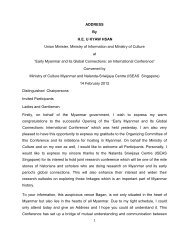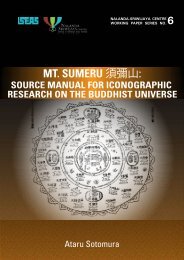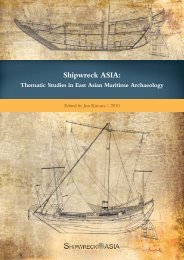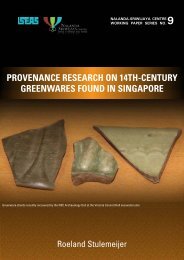Engineering expansion irrigation, population and the state in pre ...
Engineering expansion irrigation, population and the state in pre ...
Engineering expansion irrigation, population and the state in pre ...
You also want an ePaper? Increase the reach of your titles
YUMPU automatically turns print PDFs into web optimized ePapers that Google loves.
Frasch: <strong>Eng<strong>in</strong>eer<strong>in</strong>g</strong> Expansion NSC Work<strong>in</strong>g Paper No. 8<br />
builders) that were available along <strong>the</strong> Tamil coast to transport warriors to <strong>the</strong> ports on <strong>the</strong> o<strong>the</strong>r<br />
side of <strong>the</strong> Bay of Bengal. The battles were <strong>the</strong>n all fought on <strong>the</strong> l<strong>and</strong>, not on <strong>the</strong> sea. Ano<strong>the</strong>r<br />
change <strong>in</strong> military tactics that became apparent <strong>in</strong> South India is <strong>the</strong> use of horses <strong>and</strong> mounted<br />
archers. Their s<strong>pre</strong>ad over India resulted from <strong>the</strong> success of <strong>the</strong> Sultans of Delhi ‐ whose military<br />
power rested on cavalry ‐ <strong>in</strong> conquer<strong>in</strong>g nor<strong>the</strong>rn <strong>and</strong>, after 1300 CE, sou<strong>the</strong>rn India. 5 Horses <strong>in</strong>deed<br />
make an appearance <strong>in</strong> South Indian epigraphy, but hardly before c. 1200 CE <strong>and</strong> <strong>the</strong>refore, at a time<br />
when <strong>the</strong> <strong>pre</strong>dom<strong>in</strong>ance of <strong>the</strong> Cholas was wan<strong>in</strong>g aga<strong>in</strong>. The s<strong>pre</strong>ad of cannons <strong>and</strong> gunpowder <strong>in</strong><br />
South India can similarly be dated to <strong>the</strong> late 13 th <strong>and</strong> early 14 th centuries; aga<strong>in</strong>, <strong>the</strong> Delhi Sultans<br />
seem to have been both <strong>the</strong> major reason <strong>and</strong> source for <strong>the</strong>ir proliferation even though <strong>the</strong> Ch<strong>in</strong>ese<br />
too, were active <strong>in</strong> supply<strong>in</strong>g arms to Sou<strong>the</strong>ast Asia from around <strong>the</strong> middle of <strong>the</strong> 14 th century. 6<br />
Besides military technology, <strong>the</strong> demographic factor of warfare has become an important<br />
object of historical research. The existence of sizeable armies to follow a charismatic ruler is no<br />
longer taken for granted, but analysed for its number, social composition, equipment <strong>and</strong> strategy.<br />
With <strong>the</strong> exception of <strong>the</strong> Velaikkaras, a group of specialised soldiers who also ga<strong>in</strong>ed fame <strong>in</strong> Sri<br />
Lanka, 7 <strong>the</strong> study of <strong>the</strong> Chola army has hardly begun. 8 As far as numbers are concerned, this may be<br />
due to <strong>the</strong> fact that even rough estimates of <strong>population</strong> anywhere <strong>in</strong> <strong>pre</strong>‐modern South <strong>and</strong><br />
Sou<strong>the</strong>ast Asia run <strong>the</strong> risk of misre<strong>pre</strong>sentation by a wide mark. Accord<strong>in</strong>gly, <strong>the</strong>re's a general<br />
tendency <strong>in</strong> historical literature to avoid clear <strong>state</strong>ments or even to exclude demographic factors<br />
altoge<strong>the</strong>r. 9 On a very general level, <strong>the</strong>re seems to be agreement that early <strong>state</strong>s were short of<br />
people but never<strong>the</strong>less, k<strong>in</strong>gs were occasionally able to rally considerable numbers of soldiers for<br />
<strong>the</strong>ir campaigns.<br />
The agriculture of <strong>the</strong> Chola empire has long been seen <strong>and</strong> discussed as an annex to <strong>the</strong><br />
empire's adm<strong>in</strong>istrative structure (l<strong>and</strong> revenue collection, village autonomy, feudalism). 10 In such<br />
discussion, <strong>the</strong> agricultural system was seen as basically static <strong>and</strong> unchang<strong>in</strong>g. However, <strong>in</strong> <strong>the</strong><br />
1980s, this picture was revised by scholars like Nitz <strong>and</strong> Heitzman. Look<strong>in</strong>g at <strong>the</strong> ancient field marks,<br />
Nitz could show that dur<strong>in</strong>g <strong>the</strong> Chola period a significant <strong>expansion</strong> of <strong>the</strong> cultivated area took place<br />
3


